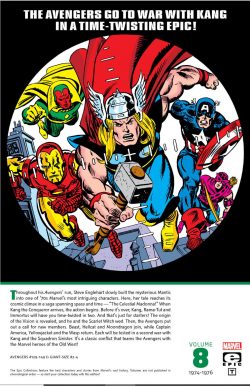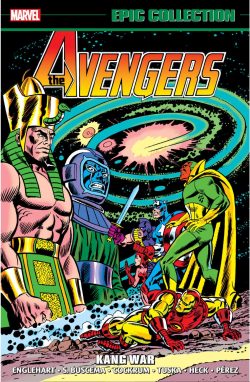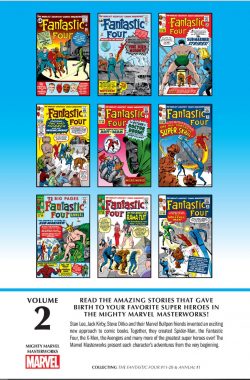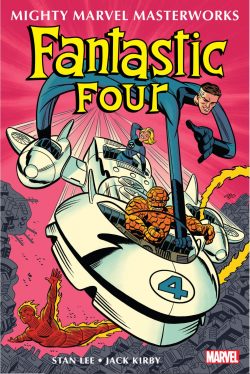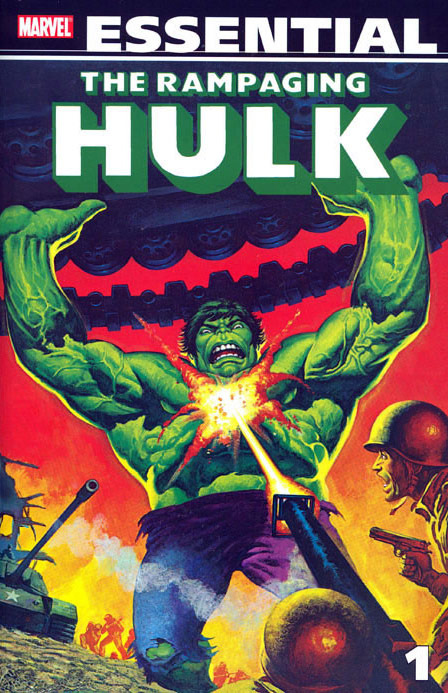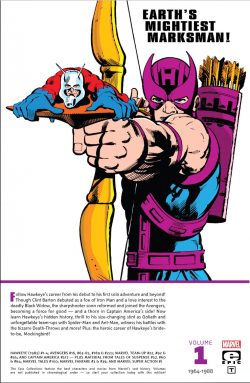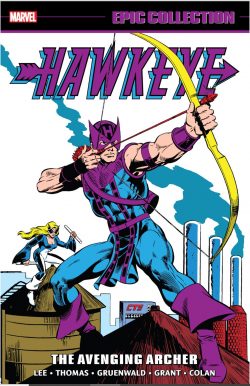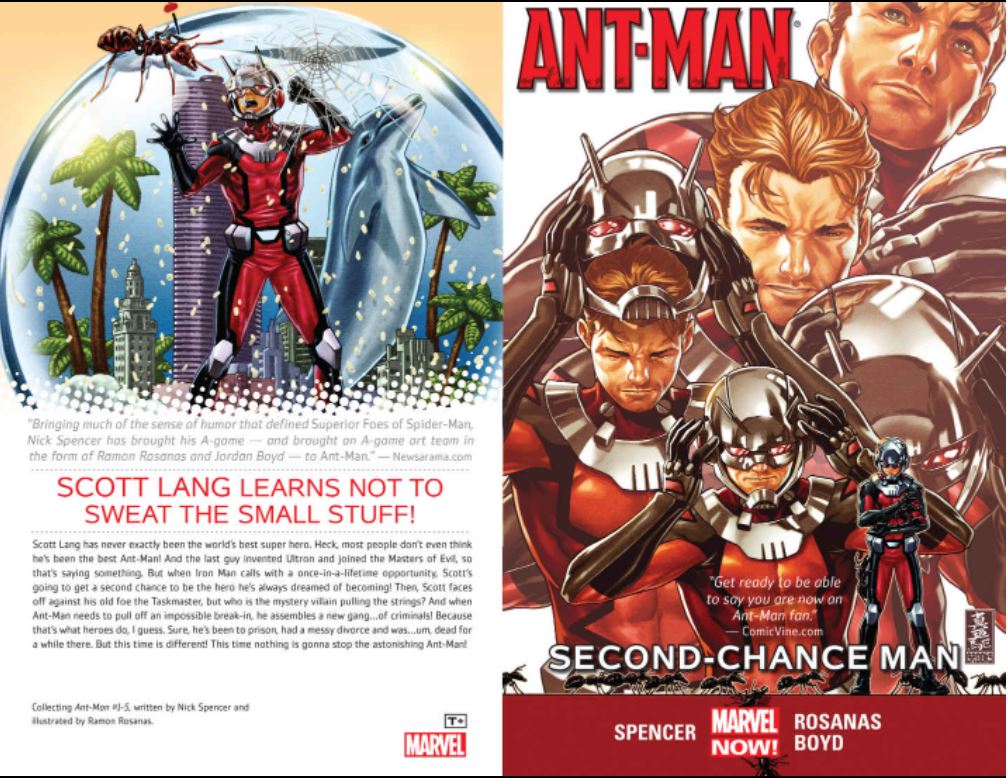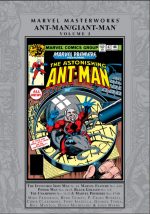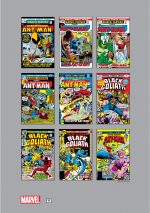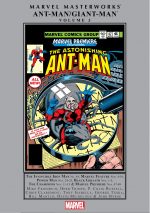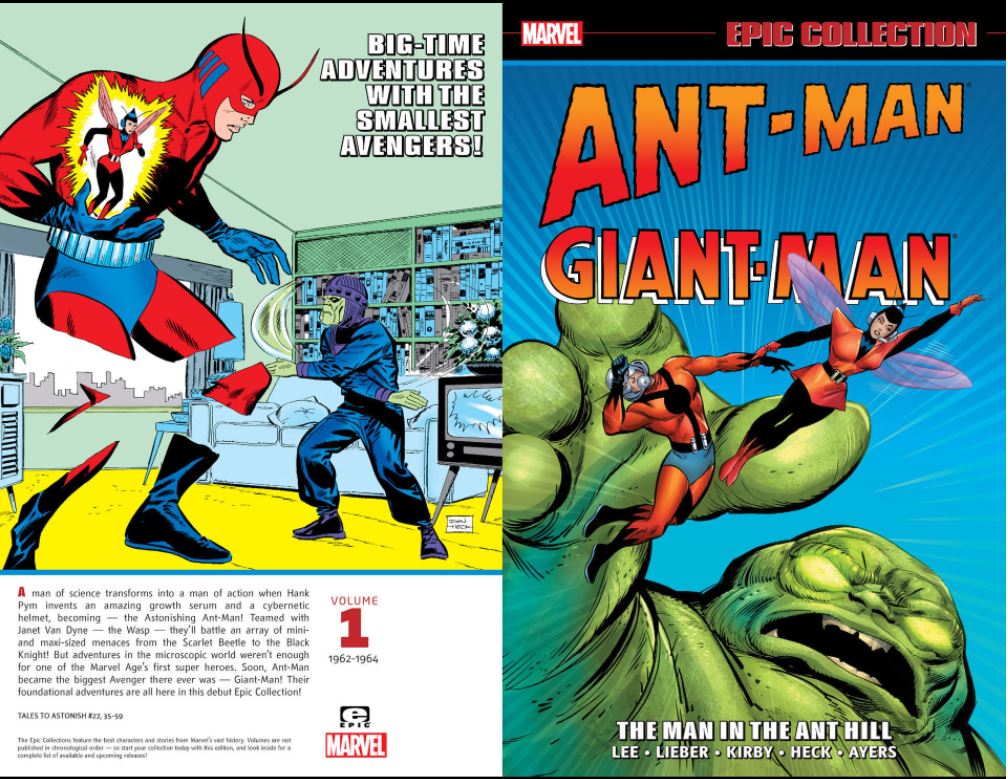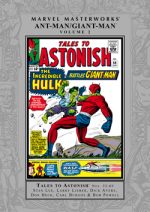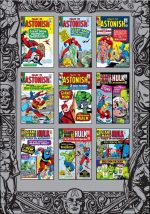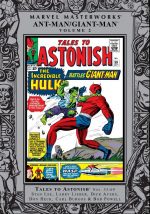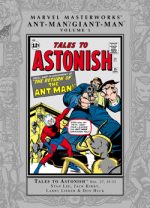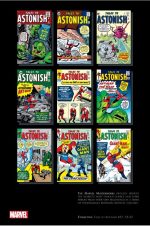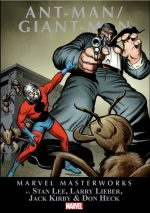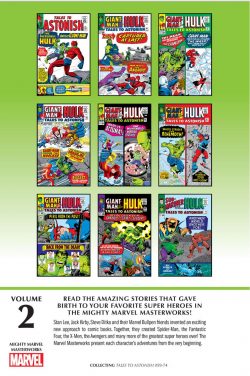
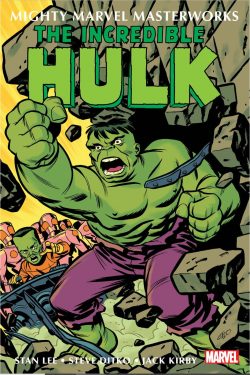
By Stan Lee, Steve Ditko, Jack Kirby, Dick Ayers, Mike Esposito, Bob Powell & various (MARVEL)
ISBN: 978-1-3029-4623-4 (TPB/Digital edition)
Their stories are timeless and have been gathered many times before, but today I’m once more focusing on format before Fights ‘n’ Tights – or is that Rags ‘n’ Shatters?
The Mighty Marvel Masterworks line was expressly designed with economy in mind. Classic tales of Marvel’s key characters as realised by the founding creators and re-presented in chronological order have been a company staple since the 1990s, but always in lavish, expensive collectors editions. These nifty nuggets are far cheaper, albeit with some deletions – such as the occasional pin-up – and with far fewer bonus features. They’re printed on lower quality paper and – crucially – are physically smaller (152 x 227mm or about the dimensions of a B-format paperback book). Your eyesight might be failing and your hands too big and shaky, but they’re perfect for kids and if you opt for the digital editions, that’s no issue at all…
Bruce Banner was a military scientist caught in the world’s first gamma bomb detonation. As a result of ongoing mutation, stress and other factors cause him to transform into a giant green monster of unstoppable strength and fury.
After an initially troubled debut run, the Gruff Green Giant finally found his size 700 feet and a format that worked, becoming one of young Marvel’s most popular features. After his first solo-title folded, The Incredible Hulk shambled around a swiftly-coalescing Marvel Universe as guest star and/or villain du jour until a new home was found for him.
1962 was a big year for burgeoning Marvel, with plenty of star debuts who all celebrate six decades of glory this year. Most oldsters will cite the Amazing Spider-Man as the most significant premier, but this guy can probably claim equal star status…
This tome gathers the Hulky bits from Tales To Astonish #59-74: spanning September 1964 to December 1965, and seeing the nomadic antihero settle down in a new home to restart his march to global fame and misfortune…
Way back then, the trigger for the Hulk’s second chance was a reprinting of his origin in the giant anthology comic book Marvel Tales Annual #1. It was the beginning of the company’s inspired policy of keeping early tales in circulation, which did so much to make fervent fans out of casual latecomers. Thanks to reader response, “Ol’ Greenskin” was awarded a back-up strip in a failing title…
Giant-Man Hank Pym was the star turn in Tales to Astonish, but by mid-1964 the strip was visibly floundering. In issue #59 the Master of Many Sizes was used to introduce his forthcoming co-star in a colossal punch-up, setting the scene for the next issue wherein the Green Goliath’s co-feature began.
The second chapter of the man-monster’s career was about to take off and power-packed prologue ‘Enter: The Hulk!’ (Stan Lee, Dick Ayers & Paul Reinman) sees the Avengers inadvertently inspire woefully insecure Giant-Man to hunt down the Jade Giant Goliath.
Although Pym’s archfoe The Human Top devilishly engineered that blockbusting battle, Lee was the real mastermind as – with the next issue – The Hulk began starring in his own series (and on the covers) whilst Giant-Man’s adventures shrank down to a dozen or so pages.
The event was heralded by a raucous house ad which supplements the story here.
In TTA #60, ‘The Incredible Hulk’ opens with Banner still working for General Thaddeus “Thunderbolt” Ross, despite the military martinet’s deep disgust and distrust of the puny milksop who had won his daughter’s heart.
Aloof and standoffish, Banner keeps secret his astounding condition: an affliction which subjects him to uncontrollable transformations, becoming a rampaging, if well-intentioned, engine of destruction.
The 10-page instalments were uncharacteristically set in the Arizona/New Mexico deserts, not New York, and espionage and military themes were the narrative backdrop of these adventures. Lee scripted, Ditko drew and comics veteran George Roussos – “George Bell” – provided the ink art. The first episode details how an anonymous spy steals an unstoppable suit of robotic armour built by radiation-obsessed Banner, and concludes with a shattering battle in the next instalment wherein the Hulk is ‘Captured at Last!’
Cliffhanger endings such as the exhausted Man-Monster’s imprisonment by Ross’ military units at the end of the yarn would prove instrumental in keeping readers onboard and enthralled. Next chapter ‘Enter… the Chameleon!’ has plenty of action and suspense with the mercenary spy infiltrating Ross’ command, but the real punch is the final panel, hinting at the mastermind behind all the spying and skulduggery. The enigmatic Leader would become the Hulk’s ultimate and antithetical nemesis…
The minor Spider-Man villain worked well as a returning foe: his disguise abilities an obvious threat in a series based on a weapons scientist working for the military during the Cold War. Even the Leader himself has dubious connections to the sinister Soviets – when he isn’t trying to conquer the world for himself.
Preceded by a titanic Jack Kirby Marvel Masterwork Pin-up of the Green Goliath, ‘A Titan Rides the Train!’ (TTA #63, cover-dated January 1965) provides an origin for the super-intellectual menace whilst setting up a fresh subplot wherein new cast addition Major Glen Talbot begins to suspect Banner is a traitor. The action component comes when the Leader tries to steal Banner’s new anti-H-bomb device from a moving freight locomotive…
‘The Horde of Humanoids!’ features the return of guilt-stricken former sidekick Rick Jones who uses his Avengers connections to obtain a pardon for the incarcerated Banner by the simple expedient of letting the American President in on the secret of the Hulk! Ah… kinder times…!
Free again, Banner joins Talbot on an isolated island to test his hotly sought-after atomic device, only to be attacked by the Leader’s artificial warriors – providing a fine example of Ditko’s unique manner of staging a super-tussle.
The chaotic clash continues into the next issue as Ayers assumes the inking. Banner is taken prisoner by those darn Commies, and sees the Hulk go ballistic behind the Iron Curtain ‘On the Rampage against the Reds!’. This gratuitously satisfyingly onslaught spans three issues, with #66 – ‘The Power of Doctor Banner!’ inked by Vince Colletta and ‘Where Strides the Behemoth’ in #67 (inked by Frank Giacoia AKA “Frank Ray”), cumulatively demonstrating the brute’s shattering might.
His Commie-Busting fury finally expended, the Hulk reverts to human form and is captured by Mongolian bandits who see a chance to make lots of ransom money…
Jack Kirby returned as illustrator – supplemented by Mike (“Mickey Demeo”) Esposito – in #68. ‘Back from the Dead!’ sees dauntless Glen Talbot extricate and exfiltrate the tragic scientist, only to lose him again on the way back to America. Even so, Banner falls again into military custody and is ordered to activate his Atomic Absorbatron for one last test…
Yet again the process is interrupted by the Leader’s attacking Humanoids, but this time the Veridian Villain succeeds and the Hulk is ‘Trapped in the Lair of the Leader!’ …but only until the US Army bursts in…
Issue #70 saw Giant-Man benched and replaced by The Sub-Mariner, making Tales to Astonish a title dedicated to aggressive, savage anti-heroes. Increasingly, Hulk stories reflected this shift, and ‘To Live Again!’ sees the furious Leader launch a 500-foot tall Humanoid against a local US missile base, with the Jade Giant caught in the middle.
Kirby reduced his input to layouts and Esposito handles the lion’s share of the art in #71’s ‘Like a Beast at Bay!’: as the despondent Hulk actually joins forces with the Leader before ‘Within the Monster Dwells a Man!’ finds Talbot getting ever closer to uncovering Banner’s dark, green secret.
With legendary illustrator Bob Powell pencilling and inking over Kirby’s layouts, ‘Another World, Another Foe!’ details how the Leader dispatches Hulk to The Watcher’s homeworld to steal an ultimate weapon, just as an “unbeatable” alien rival arrives. ‘The Wisdom of the Watcher!’ ends the quest – and apparently The Leader – in an all-out, brutal action with a shocking climax…
The book closes with a glorious lost page of Ditko’s pencils: a superb unused pin-up of the antihero and his supporting cast, that is quite frankly worth the price of admission all on its own…
To Be Hulk-inued…
Hulk Smash! He always was, and because of stories like this, he always will be…
© 2022 MARVEL.

